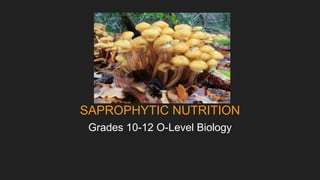
Saprophytic nutirtion
- 1. Grades 10-12 O-Level Biology SAPROPHYTIC NUTRITION
- 2. INTRODUCTION Saprophytic Nutrition This is a type of nutrition where organisms obtain their food by feeding on dead and decayed animals, plants and other organic matter. For instance, fungi, bacteria, bread moulds, etc. obtain their nutrition through this mode. They release digestive enzymes on the organic matter, which gets converted into glucose and provides them energy.
- 3. SAPROPHYTIC NUTRITION In this type, the saprophytic organisms like fungi release digestive enzymes in their surrounding medium to convert the complex organic molecules such as sugars in simple forms such as glucose. This simple food is then absorbed through the body surface, and utilized for various activities by fungus.
- 4. SAPROPHYTES These are organisms which obtain their food from dead and decaying organic matter of dead plants, dead animals and other organic matter. Saprotrophs feed by a process known as absorptive nutrition, in which the nutritional substrate (e.g., dead organism or other nonliving organic matter) is directly digested by a variety of enzymes that are excreted by the saprotroph. The enzymes convert the detris into simpler molecules, which are then absorbed by the cells to feed the organism.
- 5. Most dead organic matter is eventually broken down and used by bacteria and fungi. Slime molds are also saprophytes, as well as consuming bacteria. Examples of saprophytes are cheese mold, and yeast. The term "saprophyte" refers specifically to fungal and bacterial saprotrophs; animal saprotrophs are known as saprozoites.Other terms, such as 'saprotroph' or 'saprobe' may be used instead of saprophyte.
- 6. TYPES OF SAPROPHYTES There are three major groups of Saprophytes:These are: Bacteria Fungi Molds
- 7. IMPORTANCE OF SAPROPHTYTES These organisms feed on dead organisms and products of living organisms. They secrete enzymes on these materials that cause decomposition, and then they absorb decomposed and digested foods. They absorb only what they need to survive, the remainder of the nutrients are reabsorbed into the ecosystem.
- 8. They are essential as they unlock these nutrients, readying them for reabsorbtion. Examples include many species of bacteria and fungi. These are essential organisms to an ecosystem, since they cause recycling of materials between biotic and abiotic parts of the ecosystem.
- 9. They obtain their nutrients from dead or decomposing organic matter: mainly plant material. Fungal exoenzymes are able to break down insoluble polysaccharides, such as the cellulose and lignin of dead wood, into readily absorbable glucose molecules.
- 10. The carbon, nitrogen, and other elements are thus released into the environment. Because of their varied metabolic pathways, fungi fulfill an important ecological role and are being investigated as potential tools in bioremediation. For example, some species of fungi can be used to break down diesel oil and polycyclic aromatic hydrocarbons (PAHs). Other species take up heavy metals, such as cadmium and lead.
- 11. Some fungi are parasitic, infecting either plants or animals. Smut and Dutch elm disease affect plants, whereas athlete’s foot and candidiasis (thrush) are medically important fungal infections in humans.